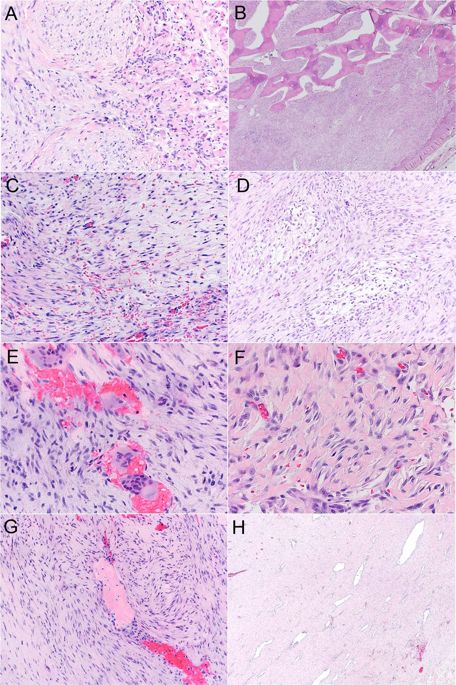当前位置:
X-MOL 学术
›
Modern Pathol.
›
论文详情
Our official English website, www.x-mol.net, welcomes your feedback! (Note: you will need to create a separate account there.)
Recurrent and novel USP6 fusions in cranial fasciitis identified by targeted RNA sequencing.
Modern Pathology ( IF 7.5 ) Pub Date : 2019-12-11 , DOI: 10.1038/s41379-019-0422-6 Vera A Paulson 1, 2 , Ivan A Stojanov 3 , Jay K Wasman 4 , Tamara Restrepo 1 , Samantha Cano 1 , Joanna Plunkitt 1 , Sekhar Duraisamy 1 , Marian H Harris 1 , Deborah J Chute 5 , Alyaa Al-Ibraheemi 1 , Alanna J Church 1
Modern Pathology ( IF 7.5 ) Pub Date : 2019-12-11 , DOI: 10.1038/s41379-019-0422-6 Vera A Paulson 1, 2 , Ivan A Stojanov 3 , Jay K Wasman 4 , Tamara Restrepo 1 , Samantha Cano 1 , Joanna Plunkitt 1 , Sekhar Duraisamy 1 , Marian H Harris 1 , Deborah J Chute 5 , Alyaa Al-Ibraheemi 1 , Alanna J Church 1
Affiliation

|
Cranial fasciitis is a benign myofibroproliferative lesion of the scalp and underlying bones typically occurring in the pediatric population. Histologically, it is characterized by loose fascicles of stellate cells in a fibromyxoid background, findings similar to those described in the closely related variant nodular fasciitis. Previously characterized as a reactive process, the identification of USP6 translocations in over 90% of nodular fasciitis cases prompted their reclassification as a clonal neoplastic process. Unlike nodular fasciitis, the molecular underpinnings of cranial fasciitis are less clear. While a subset of cranial fasciitis has been associated with Wnt/β-catenin pathway dysregulation, recent case reports suggest that this entity may also harbor USP6 fusions, a finding we sought to further investigate. We identified fifteen archival cases of cranial fasciitis, five females and ten males ranging in age from 3 months to 9 years (median 11 months), composed of formalin-fixed paraffin-embedded and fresh frozen tissues (11 and 4 cases respectively). Samples were evaluated on an RNA-based targeted sequencing panel targeting genes recurrently rearranged in neoplasia, including USP6. Five of fifteen cases (33%) were positive for USP6 rearrangements predicted to result in the fusion of the entire USP6 coding region to the promoter of the 5' partner, (three of which were novel): two SERPINH1-USP6 (novel) and one each of COL3A1-USP6 (novel), SPARC-USP6, and MYH9-USP6. These results demonstrate the recurrent nature of USP6 rearrangements in cranial fasciitis, and highlight the success of targeted RNA sequencing in identifying known and novel fusion partners. The identification of USP6 promoter-swapping rearrangements is helpful in understanding the underlying biology of cranial fasciitis, and reinforces its biologic relationship to nodular fasciitis. Targeted RNA sequencing is a helpful tool in diagnosing this pseudosarcomatous lesion.
中文翻译:

通过靶向 RNA 测序鉴定颅筋膜炎中复发和新的 USP6 融合。
颅筋膜炎是头皮和下层骨骼的良性肌纤维增生性病变,通常发生在儿科人群中。在组织学上,它的特征是纤维粘液样背景中星状细胞的松散束,与密切相关的变异型结节性筋膜炎中描述的结果相似。以前被描述为反应性过程,在超过 90% 的结节性筋膜炎病例中发现 USP6 易位促使它们被重新分类为克隆性肿瘤过程。与结节性筋膜炎不同,颅筋膜炎的分子基础不太清楚。虽然颅筋膜炎的一部分与 Wnt/β-连环蛋白通路失调有关,但最近的病例报告表明该实体也可能存在 USP6 融合,我们试图进一步研究这一发现。我们确定了 15 例颅筋膜炎档案病例,5 例女性和 10 例男性,年龄从 3 个月到 9 岁(中位数 11 个月)不等,由福尔马林固定、石蜡包埋和新鲜冷冻组织组成(分别为 11 例和 4 例)。在基于 RNA 的靶向测序面板上对样本进行了评估,该面板靶向在肿瘤中反复重排的基因,包括 USP6。15 例中有 5 例 (33%) 对 USP6 重排呈阳性,预测会导致整个 USP6 编码区与 5' 伙伴的启动子融合(其中 3 例是新的):两个 SERPINH1-USP6(新的)和COL3A1-USP6(小说)、SPARC-USP6 和 MYH9-USP6 各一个。这些结果证明了 USP6 重排在颅筋膜炎中的复发性,并强调靶向 RNA 测序在识别已知和新型融合伴侣方面的成功。USP6 启动子交换重排的鉴定有助于理解颅筋膜炎的潜在生物学,并加强其与结节性筋膜炎的生物学关系。靶向 RNA 测序是诊断这种假性肉瘤病变的有用工具。
更新日期:2019-12-11
中文翻译:

通过靶向 RNA 测序鉴定颅筋膜炎中复发和新的 USP6 融合。
颅筋膜炎是头皮和下层骨骼的良性肌纤维增生性病变,通常发生在儿科人群中。在组织学上,它的特征是纤维粘液样背景中星状细胞的松散束,与密切相关的变异型结节性筋膜炎中描述的结果相似。以前被描述为反应性过程,在超过 90% 的结节性筋膜炎病例中发现 USP6 易位促使它们被重新分类为克隆性肿瘤过程。与结节性筋膜炎不同,颅筋膜炎的分子基础不太清楚。虽然颅筋膜炎的一部分与 Wnt/β-连环蛋白通路失调有关,但最近的病例报告表明该实体也可能存在 USP6 融合,我们试图进一步研究这一发现。我们确定了 15 例颅筋膜炎档案病例,5 例女性和 10 例男性,年龄从 3 个月到 9 岁(中位数 11 个月)不等,由福尔马林固定、石蜡包埋和新鲜冷冻组织组成(分别为 11 例和 4 例)。在基于 RNA 的靶向测序面板上对样本进行了评估,该面板靶向在肿瘤中反复重排的基因,包括 USP6。15 例中有 5 例 (33%) 对 USP6 重排呈阳性,预测会导致整个 USP6 编码区与 5' 伙伴的启动子融合(其中 3 例是新的):两个 SERPINH1-USP6(新的)和COL3A1-USP6(小说)、SPARC-USP6 和 MYH9-USP6 各一个。这些结果证明了 USP6 重排在颅筋膜炎中的复发性,并强调靶向 RNA 测序在识别已知和新型融合伴侣方面的成功。USP6 启动子交换重排的鉴定有助于理解颅筋膜炎的潜在生物学,并加强其与结节性筋膜炎的生物学关系。靶向 RNA 测序是诊断这种假性肉瘤病变的有用工具。


























 京公网安备 11010802027423号
京公网安备 11010802027423号